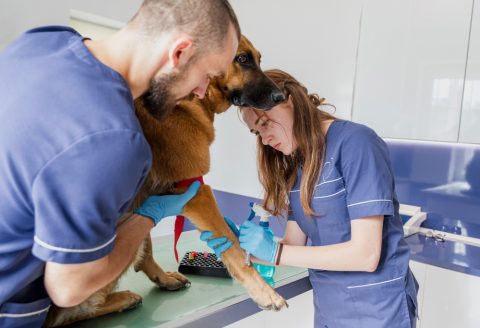Discovering blood in your dog’s stool can trigger immediate concern and worry. While this symptom shouldn’t be ignored, understanding the underlying causes can help you respond appropriately and avoid unnecessary panic. Not every instance of bloody stool indicates a serious emergency, but recognizing the warning signs that require immediate attention remains crucial for your pet’s wellbeing.
The appearance, frequency, and accompanying symptoms of bloody stool provide important clues about potential underlying conditions. Learning to interpret these signs empowers you to make informed decisions about when to monitor at home versus when to seek immediate veterinary care.
Contents
Understanding Different Types of Blood in Canine Stool
Fresh Blood Indicators and Their Significance
Recognizing Hematochezia
When you notice bright red, fresh-looking blood in your dog’s stool, veterinarians term this condition hematochezia. This type of bleeding typically originates from the lower digestive tract, including the colon, rectum, or anal area. The blood appears vibrant red because it hasn’t undergone the digestive process that would darken its appearance.
Fresh blood often indicates localized irritation or inflammation in the lower bowel regions. While concerning, these conditions frequently respond well to appropriate treatment when identified promptly.
Lower Digestive Tract Conditions
Several conditions affecting the lower digestive system can produce bright red blood in stool. Colitis, or inflammation of the colon, ranks among the most common causes and often develops from dietary indiscretions, stress, or bacterial overgrowth.
Rectal injuries or irritation from passing hard stools can also cause fresh bleeding. These mechanical injuries typically heal quickly once the underlying cause is addressed, but persistent bleeding warrants veterinary evaluation.
Darker Blood Manifestations and Serious Implications
Understanding Melena
Dark, tarry, or black blood in stool, known as melena, indicates bleeding from higher up in the digestive system. This blood has been partially digested during its journey through the intestinal tract, resulting in its characteristic dark appearance and often sticky consistency.
Melena generally signals more serious conditions than bright red blood and typically requires immediate veterinary attention. The source of bleeding could be the stomach, small intestine, or other upper digestive organs.
Upper Gastrointestinal Bleeding Sources
Stomach ulcers represent a common cause of melena in dogs. These painful lesions can develop from various factors, including certain medications, stress, or bacterial infections. Left untreated, stomach ulcers can lead to significant blood loss and serious complications.
Tumors in the upper digestive tract can also cause dark, bloody stools. While cancer remains a possibility, many gastrointestinal masses are benign and treatable when caught early.
Common Underlying Causes by Category
Dietary and Ingestion-Related Factors
Inappropriate Food Consumption
Dogs’ tendency to eat inappropriate items frequently leads to gastrointestinal bleeding. Bones, sticks, rocks, and garbage can cause mechanical damage to the digestive tract lining, resulting in bloody stools.
Sudden dietary changes can also trigger digestive upset and bleeding. Introducing new foods too quickly or feeding inappropriate human foods can disrupt the normal digestive balance and cause inflammatory responses.
Food Allergies and Sensitivities
Chronic food allergies can cause ongoing inflammation in the digestive tract, leading to intermittent bloody stools. Dogs with food sensitivities may experience recurring episodes of digestive upset, often accompanied by other symptoms like skin irritation or ear infections.
Identifying and eliminating trigger foods often resolves these chronic bleeding episodes. However, proper diagnosis requires systematic dietary trials under veterinary guidance.
Infectious and Parasitic Causes
Bacterial and Viral Infections
Various infectious agents can cause bloody diarrhea in dogs. Bacterial infections like salmonella or campylobacter often produce acute symptoms including bloody, watery stools accompanied by vomiting and fever.
Viral infections, particularly parvovirus in unvaccinated puppies, can cause severe bloody diarrhea and rapid dehydration. These conditions require immediate veterinary intervention to prevent life-threatening complications.
Parasitic Infestations
Intestinal parasites commonly cause bloody stools in dogs of all ages. Hookworms, whipworms, and coccidia can damage the intestinal lining, leading to bleeding and digestive upset.
Regular parasite prevention and routine fecal examinations help identify and treat these infections before they cause significant symptoms or complications.
Anatomical and Mechanical Issues
Anal Gland Problems
Impacted or infected anal glands can cause small amounts of bright red blood in stool. These paired glands, located on either side of the anus, normally empty during defecation but can become blocked or infected.
Dogs with anal gland issues may also scoot their bottom on the ground, lick excessively at their rear end, or show signs of discomfort when sitting.
Structural Abnormalities
Rectal polyps, tumors, or other growths can cause bleeding during defecation. While many of these growths are benign, proper veterinary evaluation is necessary to determine appropriate treatment options.
Intussusception, where one portion of intestine telescopes into another, can also cause bloody stools and represents a surgical emergency requiring immediate intervention.

Recognizing Emergency Situations
Critical Warning Signs
Systemic Symptoms Requiring Immediate Care
Certain combinations of symptoms alongside bloody stool indicate emergency situations requiring immediate veterinary attention. Weakness, lethargy, pale gums, or collapse suggest significant blood loss or systemic illness.
Persistent vomiting combined with bloody diarrhea can lead to rapid dehydration and electrolyte imbalances, particularly dangerous for puppies and senior dogs.
Signs of Shock and Severe Blood Loss
Dogs experiencing significant blood loss may develop shock, characterized by rapid heart rate, weak pulse, and cold extremities. Gums may appear pale or white instead of the normal pink color.
Any dog showing signs of shock requires emergency veterinary care. These symptoms can progress rapidly and become life-threatening without prompt intervention.
Acute Versus Chronic Presentations
Sudden Onset Bloody Stools
Acute bloody diarrhea that develops suddenly often indicates serious conditions requiring immediate attention. Possible causes include poisoning, foreign body ingestion, or severe infections.
Dogs with acute presentations may show obvious signs of distress, including restlessness, panting, or attempts to defecate without producing stool.
Chronic Intermittent Bleeding
Chronic bloody stools that occur sporadically over weeks or months suggest different underlying conditions than acute presentations. These cases often involve inflammatory bowel disease, food allergies, or chronic infections.
While chronic cases may not require emergency care, they still need veterinary evaluation to identify underlying causes and prevent progression to more serious conditions.
Diagnostic Approaches and Veterinary Evaluation
Initial Assessment and History Taking
Providing Detailed Information
When consulting your veterinarian about bloody stools, prepare to provide detailed information about your dog’s symptoms, including when they started, frequency, and any associated signs like vomiting or appetite changes.
Information about recent dietary changes, access to inappropriate items, or changes in routine helps veterinarians narrow down potential causes and develop appropriate diagnostic plans.
Physical Examination Findings
Veterinary examination typically includes assessment of hydration status, abdominal palpation for pain or masses, and evaluation of mucous membrane color to assess for blood loss.
Rectal examination may reveal external causes of bleeding, such as anal gland problems or rectal masses, allowing for targeted treatment recommendations.
Diagnostic Testing Options
Laboratory Evaluations
Blood work helps assess overall health status and identify signs of dehydration, anemia, or infection. Complete blood counts can reveal evidence of blood loss or inflammatory processes.
Fecal examinations check for parasites, bacterial overgrowth, or other infectious causes of bloody stool. Multiple samples may be necessary to identify certain parasites reliably.
Advanced Imaging Studies
Radiographs (X-rays) can identify foreign objects, intestinal obstructions, or masses that might cause bleeding. Contrast studies may be necessary to visualize soft tissue structures more clearly.
Ultrasound examination provides detailed images of abdominal organs and can identify masses, inflammation, or other structural abnormalities contributing to bloody stools.
Treatment Strategies and Home Management
Immediate Care Measures
Supportive Care at Home
For mild cases of bloody stool without systemic symptoms, veterinarians may recommend supportive care including dietary modifications and close monitoring.
Temporarily withholding food for 12-24 hours can help rest the digestive system, followed by gradual reintroduction of bland, easily digestible foods.
Monitoring Guidelines
Keep detailed records of bowel movements, including frequency, consistency, and amount of blood present. Note any changes in appetite, energy level, or other symptoms.
Contact your veterinarian if symptoms worsen, new symptoms develop, or if bloody stools persist beyond a few days despite supportive care.
Medical Interventions
Targeted Treatments
Treatment varies significantly depending on the underlying cause of bloody stool. Bacterial infections may require antibiotics, while parasitic infections need specific antiparasitic medications.
Inflammatory conditions might respond to anti-inflammatory medications or dietary changes, while mechanical obstructions could require surgical intervention.
Long-term Management
Chronic conditions like inflammatory bowel disease or food allergies often require ongoing management including specialized diets, medications, or regular monitoring.
Working closely with your veterinary team ensures optimal management of chronic conditions and helps prevent recurrence of symptoms.
Prevention and Long-term Health Maintenance
Preventive Measures
Dietary Management
Maintaining consistent, high-quality nutrition helps prevent many causes of bloody stool. Avoid sudden dietary changes and limit access to inappropriate food items or garbage.
Regular feeding schedules and portion control help maintain digestive health and reduce the risk of gastrointestinal upset.
Parasite Prevention
Consistent parasite prevention protocols protect against many infectious causes of bloody stool. Regular fecal examinations help identify parasitic infections before they cause significant symptoms.
Maintaining clean living environments and proper waste disposal reduce exposure to infectious agents that can cause digestive upset.
Ongoing Health Monitoring
Regular Veterinary Care
Routine veterinary examinations help identify potential health issues before they progress to serious conditions. Senior dogs may benefit from more frequent check-ups to monitor for age-related changes.
Maintaining current vaccinations protects against infectious diseases that can cause bloody diarrhea and other serious complications.
Owner Vigilance
Familiarize yourself with your dog’s normal bowel movement patterns so you can quickly identify changes that might indicate health problems.
Prompt attention to digestive symptoms often leads to better outcomes and prevents minor issues from developing into serious conditions requiring extensive treatment.








